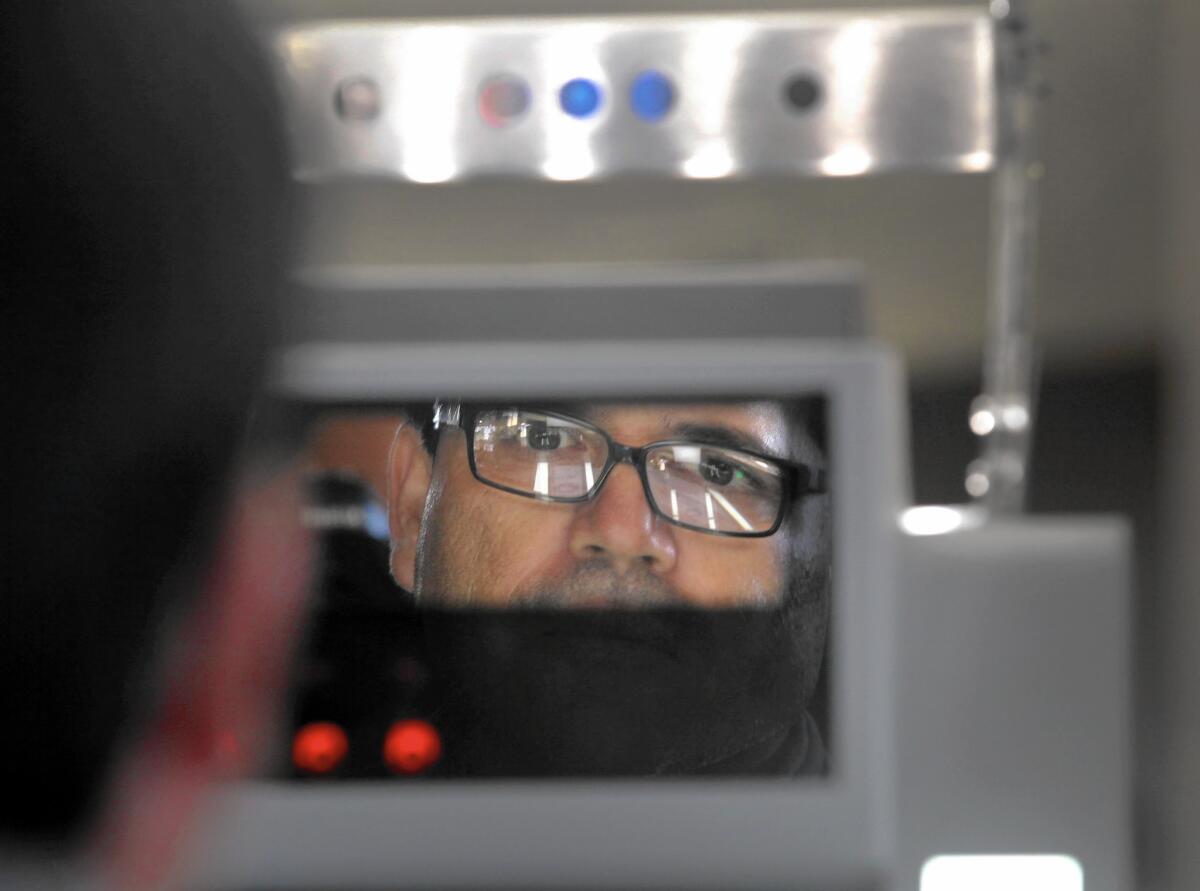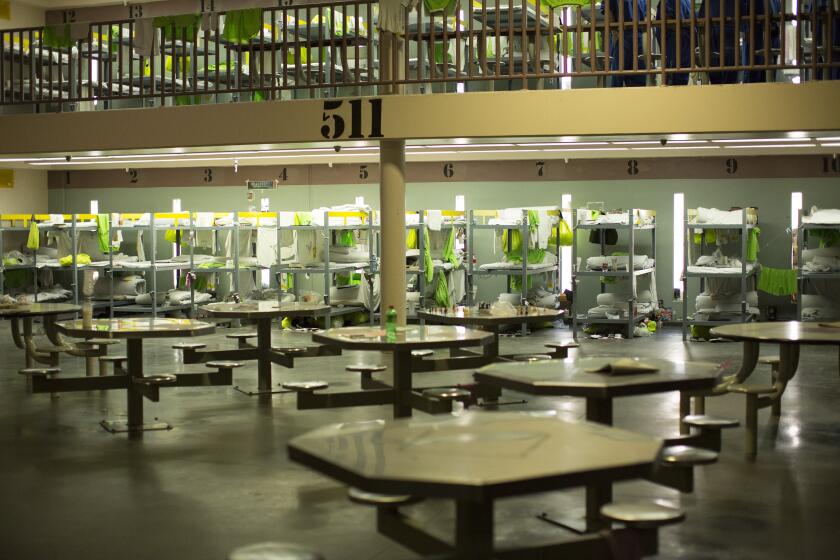Otay Mesa border crossing launches testing of facial recognition technology

A man stands before a biometric machine being tested at the Otay Mesa port of entry. The system scans the face and irises and records the information, which will be used to track non-U.S. citizens who travel across the border.
- Share via
Reporting from SAN DIEGO — For the first time on the U.S. southern border, authorities are conducting facial and iris scans on foreigners entering the country, part of a congressionally mandated effort aimed at cracking down on those who remain in the United States with expired visas.
Under a pilot program launched last week at the Otay Mesa port of entry, U.S. Customs and Border Protection is gathering biometric data from most non-U.S. citizens entering through the pedestrian lanes. Starting in February, the agency plans to also record their departure.
“We need to verify that the person that came into the United States is the same person that’s exiting the United States,” said Joe Misenhelter, assistant port director. “This is a test to determine in the pedestrian environment whether we can do that with this technology.”
Congress has for years been pressuring the U.S. Department of Homeland Security, which oversees the customs agency, to keep track not only of those who enter the United States, but also those who leave. A 2006 study by the Pew Hispanic Center estimated that between 40% and 50% of the country’s unauthorized population involves “visa overstays,” people who enter the country legally with non-immigrant visas but remain after the visas expire.
The pilot program relies on new technologies that in recent years have expanded the possibilities for biometrics, which uses physical characteristics to identify an individual. While law enforcement agencies have long relied on fingerprints to determine identity, new methods that read the iris — the colored part of the eye — as well as facial characteristics such as bone structure are able to identify individuals at a distance.
“The benefit of biometrics is that you have a much more accurate picture of identity than you had before,” said James Andrew Lewis, a technology expert at the Center for Strategic and International Studies in Washington, D.C. “No more false identities. It’s going to be harder and harder to pretend you’re someone else.”
The initial phase of the Otay Mesa project involves gathering information on most non-U.S. citizens who arrive on foot at Otay Mesa; crossers younger than 14 or older than 79 are among those exempt. To record the data, the customs agency has installed six new kiosks that can read irises and record facial characteristics, a process that takes seconds.
Large signs and a video explain the process, telling crossers that new technology is being tested and to expect a wait. Several crossers interviewed didn’t know their faces had been scanned. “I wasn’t sure what it was,” said Tijuana resident Dolores Farias, 58, who owns a small cross-border trucking business.
But Carlos Escamilla, a 27-year-old project engineer who was crossing to buy Christmas presents, said he understood that the process was for face and iris recognition, and “it’s no problem for me. I understand the point exactly.”
The customs test at Otay Mesa is part of an overall effort by the agency to collect biometric information and test the new technology in different environments, including airports, to identify impostors and confirm the departure of foreign visitors.
Otay Mesa for years has been used to test new technologies and approaches to border management, including the use of kiosks that read documents and segmentation of traffic through Sentri and the Ready Lane, two dedicated primary crossing lanes. “It’s a very good, structured environment to do that,” Misenhelter said.
At one of the busiest ports on the Mexican border, Otay’s pedestrian lanes see 8,000 to 9,000 northbound crossers a day, slightly more than half of whom are non-U.S. citizens.
The test, which runs through June, initially involves only the collection of biometric data from northbound foreign visitors. But starting in February, a second phase will involve tracking pedestrians who cross into Mexico.
For that phase, the southbound crossers will be separated into categories. All travelers will provide their travel documents, “identical to what they already provide when entering the United States,” a customs agency statement said. Non-U.S. citizens with radio-frequency identification documents such as the updated U.S. visa card will step through a control area, with the aim of testing high-tech readers and facial biometric cameras that are supposed to match the image to the database.
U.S. citizens as well as foreigners with documents that are not RFID-enabled, will be sent to kiosks to swipe their documents. Crossers without documents or with unreadable documents such as birth certificates will be processed manually.
“No biometric data will be requested from U.S. citizens either on entry or exit,” the customs statement said.
The program comes amid rising concern over the need to track foreigners leaving the country, but also the potential abuse of the new technology.
“Every country has a right to know who’s coming in and out of its border,” said Jay Stanley, a senior policy analyst for the American Civil Liberties Union’s national office. “The thing about iris scans as opposed to fingerprints is that the technology is moving toward the ability to capture at a distance without the subject’s knowledge or permission.”
As the country expands its use of biometrics to monitor foreign visitors, U.S. citizens are likely to get the same treatment from foreign governments, he said. “We could be looking at a future where governments around the world have large databases on Americans’ iris scans.”
The customs statement said that “the images taken during the testing will be used for purposes of this limited project only and will not be retained or shared with any other party or system. CBP remains committed to protecting the privacy of all travelers.”
sandra.dibble@sduniontribune.com
Dibble writes for the San Diego Union Tribune.
ALSO
LAX-to-Cuba charter flights take off for first time
After San Bernardino shooting, this gun show could get a crowd twice as big as usual
What might Southern California look like in the not-so-distant future?
More to Read
Sign up for Essential California
The most important California stories and recommendations in your inbox every morning.
You may occasionally receive promotional content from the Los Angeles Times.










